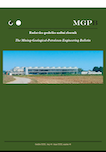The simultaneous effect of moisture and pyrite on coal spontaneous combustion using CPT and R70 test methods
DOI:
https://doi.org/10.17794/rgn.2019.3.1Keywords:
Coal Spontaneous Combustion, Moisture, Pyrite, CPT Method, R70 MethodAbstract
Among fossil fuels, coal is the most widely used all over the world for generating power and electricity and it is a stable source of energy. Despite all these benefits, coal mining has serious hazards, such as coal spontaneous combustion. There are many factors that influence the tendency for coal to spontaneously combust in coal mines. Pyrite can promote the risk of this phenomenon. This promotion is accelerated by the combination of pyrite and moisture content at the same time. This combination is very rarely discussed in literature. So, in this research, the accelerating effect of reactive pyrite and moisture content on coal spontaneous combustion was measured experimentally using crossing point temperature (CPT) and R70 test methods. For this purpose, a new experimental apparatus was assembled and made in Iran. Reaction rate data obtained from the experimental results showed that pyrite has a twofold action. It first catalyzes the oxidation reaction. Then, in a moist environment, pyrite is itself oxidized, which provides a secondary heat source, and so accelerates the process of coal spontaneous combustion. Since the pyrite oxidation reaction consumes moisture, there is a mutual effect of accelerated heating as less heat is used up in moisture evaporation. The results show that pyrite content can linearly accelerate the coal spontaneous combustion process, while moisture content under 20% increases it, and if the moisture exceeds 20%, the rate of this process is reduced. The results of this research are helpful in the assessment and management of coal spontaneous combustion issues in coal mines.
Downloads
Published
How to Cite
Issue
Section
License
Copyright (c) 2019 authors and journal

This work is licensed under a Creative Commons Attribution 4.0 International License.
Creative Commons-BY
Authors who publish with this journal agree to the following terms:
In agreeing this form, you certify that:
- You read the ethical codex of the RGN zbornik available at journal web.
- You submitted work is your original work, and has not previously been published and does not include any form of plagiarism.
- You own copyright in the submitted work, and are therefore permitted to assign the licence to publish to RGN zbornik.
- Your submitted work contains no violation of any existing copyright or other third party right or any material of an obscene, libellous or otherwise unlawful nature.
- You have obtained permission for and acknowledged the source of any illustrations, diagrams or other material included in the work of which you are not the copyright owner.
- You have taken due care to ensure the accuracy of the work, and that, to the best of your knowledge, there are no false statements made within it.
- All co-authors of this submitted work are aware of, and in agreement with, the terms of this licence and that the submitted manuscript has been approved by these authors.
Publication licence
You retain copyright in your submitted work, according to journal license policy (CC-BY). By signing this form you agree that RGN zbornik may publish it under the publication licence. In summary the licence allows the following:
Anyone is free:
- To copy, distribute, display, and perform the work.
- To make derivative works.
Under the following conditions:
- The original author must always be given credit.
- The work may not be used for commercial purposes.
- If the work is altered, transformed, or built upon, the resulting work may only be distributed under a licence identical to this one.
Exceptions to the licence
In addition to publishing the work printed under the above licence, RGN zbornik will also enable the work to be visible online.
The journal editorial can change the licence rules anytime but it cannot retroactively restrict author(s) rights.


